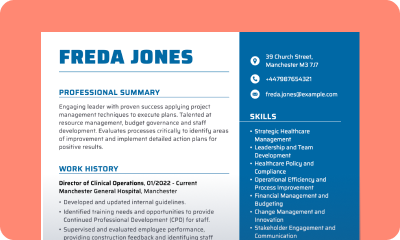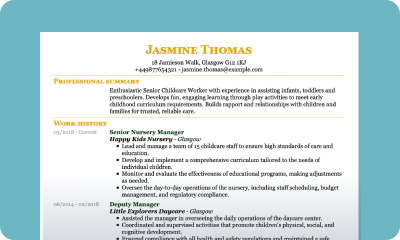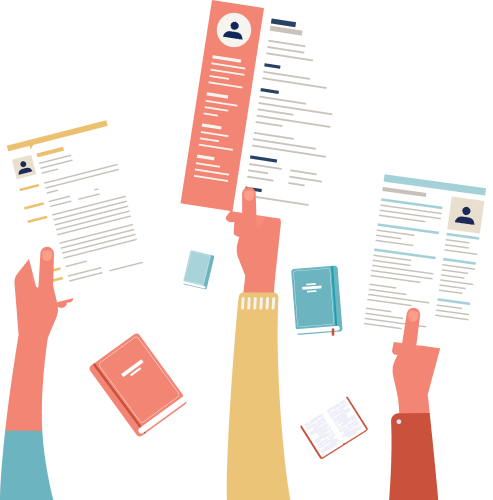How to Put Language Proficiency Levels on a CV (2026 Guide)
Adding language skills to your CV can help you stand out in a competitive job market. But how do you prove your proficiency levels? This guide explains CV language levels, frameworks like CEFR, and certification options. Plus, you’ll see practical CV language examples that will help you write your CV.

Our customers have been hired by: *Foot Note
In today’s global job market, language skills are more valuable than ever. Whether you’re fluent or conversational in several foreign languages, showcasing these language skills on your CV can give you an edge over other candidates.
In this guide, you’ll learn everything you need to know about how to list languages on a CV, from choosing the right placement to understanding language proficiency levels. You’ll also see practical languages on CV examples, along with common mistakes to avoid.
Example of how to put language levels on a CV
Emma Clarke
London, UK
+44 7912 345678
Email: emma.clarke@email.com
LinkedIn: linkedin.com/in/emmaclarke12
Personal Profile
Detail-oriented Translator with 7+ years’ experience delivering accurate and culturally sensitive translations for legal, business, and technical documents. Managed high-volume projects under tight deadlines, achieving 98% client satisfaction rates. Fluent in English, French, and Spanish. Eager to support Connector Inc. with multilingual communication and drive seamless cross-border collaboration.
Work Experience
Senior Translator
Global Language Solutions, London
Mar 2021 – September 2025
- Translated and proofread over 1.2M words annually across English, French, and Spanish, meeting strict quality assurance standards.
- Reduced project turnaround times by 22% through the implementation of AI-assisted translation tools.
- Managed a team of 4 junior translators, improving consistency and reducing errors by 30%.
- Localised websites and marketing materials, increasing international client engagement by 18%.
Freelance Translator
Various Clients (Legal, Finance, Technology)
Jan 2018 – Feb 2021
- Delivered certified translations of contracts, financial reports, and technical manuals with a 99% on-time delivery rate.
- Built and maintained long-term partnerships with 12 recurring corporate clients.
- Supported NGOs with pro bono translation services, reaching audiences across 5 European countries.
Education
MA in Translation Studies
University of Leeds
Sep 2013 – Jun 2015
BA in Modern Languages (French & Spanish)
King’s College London
Sep 2010 – Jun 2013
Skills
- CAT Tools: SDL Trados, MemoQ, Wordfast
- Terminology Management
- Proofreading & Editing
- Localisation & Transcreation
- Project Management
- Cross-Cultural Communication
- Attention to Detail
- Client Relationship Management
Language levels
- English – Native
- French – C2 (CEFR) | IELTS 8.5 (2024)
- Spanish – C1 (CEFR) | DELE Certified (2019)
- German – B2 (CEFR, Conversational Professional Use)
Certifications
- IELTS Academic – Overall Band 8.5 (2024)
- DELE C1 – Instituto Cervantes (2019)
- SDL Trados Studio Advanced Certification (2022)
Professional Memberships
- Institute of Translation & Interpreting (ITI), Member since 2018
Achievements
- Awarded “Translator of the Year” at Global Language Solutions (2022)
- Speaker at the European Language Industry Association Conference (2023)
Should I include languages on a CV?
Language skills aren’t just an extra line on your CV. They can be a competitive advantage that helps you stand out in a crowded job market. Whether you’re applying for an international company, a client-facing role, or a position that involves travel, employers often see multilingual candidates as more adaptable and resourceful, and with better problem-solving skills.
When language skills strengthen your CV:
- Global companies: Many organisations operate across borders, so fluency in languages like Spanish, French, or Mandarin can be a huge asset.
- Customer-facing roles: Sales, customer service, or hospitality jobs often require communication with diverse clients.
- Specialised industries: Roles in diplomacy, law, international relations, or translation demand strong language skills.
- Career progression: Even if the role doesn’t explicitly require another language, having it on your CV shows versatility and can set you up for future opportunities.
Language proficiency levels on a CV
Choosing the right way to present your language skills on a CV is crucial. Using a recognised framework makes your abilities clear to employers and avoids any confusion. Below are the most common options, each with its own strengths.
1. CEFR (Common European Framework of Reference for Languages)
The CEFR framework is the most widely recognised framework across Europe and is increasingly used by global employers. Recruiters in the UK and EU know exactly what each level means, so including it on your CV gives your skills instant credibility. It’s especially useful for international roles, where consistency matters, as it allows hiring managers to compare candidates fairly.
Levels:
- A1 – Beginner
- A2 – Elementary
- B1 – Intermediate
- B2 – Upper Intermediate
- C1 – Advanced
- C2 – Proficient (Mastery)
Language skills example (CEFR)
Languages
Spanish – C1 (Advanced)
German – B2 (Upper Intermediate)
2. ILR (Interagency Language Roundtable)
The ILR scale is most common in the United States, especially for government, defence, and diplomatic roles. It gives employers a very precise understanding of whether you can use a language in a casual, professional, or native-level setting. This makes it particularly valuable in jobs where communication quality could have major consequences, such as policy, law, or negotiations.
Levels (0–5 scale):
- 0 – No Proficiency
- 1 – Elementary
- 2 – Limited Working Proficiency
- 3 – Professional Working Proficiency
- 4 – Full Professional Proficiency
- 5 – Native/Bilingual Proficiency
Language skills example (ILR)
Languages
Thai – ILR 4 (Full Professional Proficiency)
Mandarin – ILR 3 (Professional Working Proficiency)
3. ACTFL (American Council on the Teaching of Foreign Languages)
The ACTFL guidelines are often used in the US, particularly in education, academic research, and language teaching roles. This framework is more detailed than most, as it splits levels into “low, mid, high,” which makes it ideal if you want to show a nuanced picture of your abilities. Employers value this system for its precision.
Levels:
- Novice (Low, Mid, High)
- Intermediate (Low, Mid, High)
- Advanced (Low, Mid, High)
- Superior
- Distinguished
Language skills example (ACTFL)
Languages
French – Advanced High (ACTFL)
Spanish – Advanced Low (ACTFL)
4. Exam-based certifications
Standardised language exams are one of the strongest ways to prove your skills, since they carry official recognition worldwide. Many employers prefer to see a recent certificate as it shows verified ability rather than self-assessment.
Certifications can include:
- English: IELTS, TOEFL, Cambridge (CPE/CAE)
- French: DELF/DALF
- German: Goethe-Zertifikat
- Spanish: DELE
Language skills example (Certifications)
Languages
English – IELTS 7.5 (2024)
French – DELF B2 (2023)
5. Plain descriptors
Many UK CVs use plain words such as beginner, intermediate, or fluent to describe language ability. This approach is straightforward for anyone to understand, even if they’re unfamiliar with formal frameworks. The downside is vagueness.
Descriptors:
- Beginner
- Intermediate
- Advanced
- Fluent
- Native/Bilingual
Language skills example (Descriptors)
Languages
Italian – Fluent
Portuguese – Intermediate
6. Custom employer-specific descriptions
Sometimes, the most effective way to describe your language skills is to explain them in context. Instead of relying on a framework, you can simply state what you’re able to do, for example, whether you can negotiate contracts, participate in technical discussions, or hold casual conversations. This method works best if the employer values practical application over formal assessment.
Sample wording:
- “Conversational Spanish (comfortable in business meetings)”
- “Fluent in French (negotiation and report-writing level)”
Pro Tip: If you’re applying in Europe, use CEFR. For US-based roles, ILR or ACTFL may be more appropriate. To make your application stronger, combine a framework with certifications where possible (e.g., Spanish – C1 CEFR, DELE Certified).
How to self-assess your language skills for a CV
Not everyone has formal certifications like IELTS or DELE, but you can still include language skills on a CV by honestly self-assessing your level. Recruiters value transparency, so it’s better to describe your real abilities than risk overstating them.
Here are some practical ways to evaluate yourself:
- Everyday communication: Ask yourself, can you hold conversations in everyday situations? Ordering food, asking for directions, or chatting socially suggests at least an Intermediate level.
- Workplace readiness: Think about whether you could attend meetings, write emails, or give a presentation in the language. If so, you’re likely at an Advanced or Fluent level.
- Reading and writing: Consider how comfortable you are reading reports, academic texts, or writing formal documents. This often separates Intermediate from Advanced.
- Native-like proficiency: If you use two languages daily without effort, whether from childhood or immersion, you can describe yourself as Bilingual or Native.
- Compare to frameworks: Use the CEFR scale (A1–C2) as a guide. For example, if you can understand detailed texts and debate complex topics, you’re probably around C1.
What do different language levels mean
In simple terms, here is a basic breakdown of each language level and what it means:
- Beginner – You know the basics and can handle simple greetings, phrases, and everyday vocabulary.
- Intermediate – You can manage routine conversations, read simple documents, and participate in discussions with some effort.
- Advanced – You can work fluently in most situations, write reports, and understand complex conversations.
- Fluent – You can express yourself clearly and naturally, both verbally and in writing, with little difficulty.
- Native/Bilingual – You’ve spoken the language since childhood or are equally proficient in two languages.
Never overstate your abilities. Employers may switch to another language during an interview to test you. Being honest about your proficiency saves you from awkward situations.
How and where to put languages on a CV
There are several places where you can highlight your language skills on a CV. Depending on what you want your CV to look like, you can include them in the following ways:
- Dedicated “Languages” section:
If speaking multiple languages is a major asset in your field (e.g., international business, diplomacy, customer support, or tourism), create a separate section titled Languages. This makes your skills immediately visible and shows you take them seriously. - Skills section:
If languages complement your profile but aren’t the main focus, add them under your skills section alongside technical and soft skills. - Education section:
When you’ve earned a formal certificate during your studies (like IELTS or DELF), you can list it under the education section. This adds credibility and highlights your qualifications. - Personal profile:
For multilingual candidates applying to roles where languages are a key differentiator, it’s smart to highlight them in your CV personal statement.
Common mistakes when adding languages to a CV
Many candidates weaken their applications by listing language skills incorrectly. To make your CV shine, here are some pitfalls to avoid:
- Being vague: Writing “Spanish – good” or “French – basic” doesn’t tell employers much. Use recognised levels like CEFR or clear descriptors such as Intermediate or Fluent.
- Overstating ability: Claiming fluency when you’re only conversational can backfire in an interview or on the job. Be honest — recruiters value accuracy over exaggeration.
- Listing too many languages: Including six or seven languages at once (especially if you’re only a beginner) can clutter your CV. Focus on those most relevant to the role.
- Skipping certifications: If you’ve taken exams like IELTS or DELF, don’t hide them. Adding certifications boosts credibility.
- Placing them in the wrong spot: Don’t bury your language skills at the bottom if they’re central to the role. Make them visible by creating a dedicated Languages section or including them in your Personal Profile.
- Mixing frameworks: If you’re using CEFR for one language and ILR for another, the CV may look inconsistent. Stick to one system unless there’s a strong reason to mix.
Key takeaways
- Languages can set you apart. In today’s global job market, being multilingual makes you more competitive and opens up international opportunities.
- Use a recognised framework. CEFR is the most widely accepted in Europe, while ILR and ACTFL are common in the US. If possible, pair levels with certifications.
- Choose the right placement. Create a Languages section if they’re central to the role, or list them under Skills, Education, or your Personal Profile when relevant.
- Be clear and honest. Always describe your level of proficiency (e.g., “French – B2, CEFR”) and avoid vague terms like “good” or “basic.”
- Link to achievements. Whenever possible, show how your language skills added value in past roles — whether in sales, customer service, research, or team collaboration.
FAQ: Language skills on a CV
Should I include languages on my CV if I only know the basics?
It depends on the job. If the role specifically mentions the language in the job description, even basic knowledge could give you an advantage, so it’s worth including. However, if your ability is very limited and not relevant to the role, leave it off.
Should I include my native language on a CV?
It isn’t necessary, unless you’re applying for a job in a different country. If you know several languages, you can include your native language for clarity.
How do I show language certifications on my CV?
Include your certifications under a dedicated Languages section or your Certifications section. Be specific: name the qualification, the level, the year, and the awarding body. This boosts credibility and reassures employers that your CV language skills are officially verified.
What’s the difference between fluent and bilingual on a CV?
Fluent means you can communicate easily in most professional and personal settings, though it may not be at the level of a native speaker. Bilingual means you are equally comfortable in two languages, often having grown up with both or using them daily in different contexts. Use Fluent if you’re very strong but not native, and Bilingual only if both languages are at the same level.
How do employers check the accuracy of language skills on a CV?
Employers may verify your language skills during the interview process by switching part of the conversation to the language you’ve listed. Some companies, especially in international business, also use language assessments or written tests. If you’ve included certifications (like IELTS or DELE), these often serve as proof.

Mariusz Wawrzyniak
Content Writer
Mariusz is a career expert at MyPerfectCV who writes practical, research-based guides that help professionals from all industries craft impactful CVs, write compelling cover letters, and advance their careers.
*The names and logos of the companies referred to above are all trademarks of their respective holders. Unless specifically stated otherwise, such references are not intended to imply any affiliation or association with myperfectCV.










